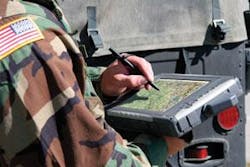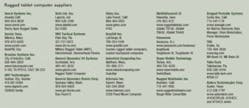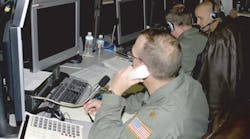By John Keller
People in the military who routinely use checklists ought to consider rugged tablet computers—particularly if they work outside or in other potentially harsh operating environments, manufacturers say.
“You don’t want to carry a laptop on a carrier flight deck; you want a tablet strapped to your leg or your waist,” says Jim Vercruyssen, product manager for tablet computing at General Dynamics Itronix Corp. in Spokane Valley, Wash.
The rugged tablet computer market breaks down essentially into two segments: the convertible, or a laptop computer with a reversible touch screen; and the slate, which has a touch screen, some function buttons, but no keyboard.
“The slate market is a small-form-factor, powerful handheld device in a form more like a clipboard,” Vercruyssen explains. “Anything you do in paper, like a checklist or inventory, is easily converted to a slate.”
Think of a slate computer as a large-screen PDA with a much faster processor, Windows-like functionality, and often with a direct wireless network connection to computer servers to convey data in real time, and also to lessen the need for large amounts of data storage in the tablet, like hard disks.
“Anyone who is doing forms applications, like lists and field inspections, is a potential user of rugged tablets,” says Robert Farr, business development manager for the Panasonic Computer Solutions federal segment in Secaucus, N.J. “On the flight line are a lot of tablet users, and also anyone doing logistics, moving inventory, and doing any kind of checklist operations.”
The popularity of tablet computers—particularly for military and aerospace applications—is growing, and manufacturers are responding with several innovations.
Although the market for rugged laptop computers is about three times the size of that of rugged tablets, the rugged tablet market is growing much more quickly, says Ben Thacker, vice president of strategic marketing at General Dynamics Itronix.
“Our rugged tablet customers are asking for information assurance; this is why you see growth in the rugged market in general,” says Panasonic’s Farr. “Users need to access information anytime, anywhere—especially in mission-critical applications where they can’t have data fail.”
So how rugged is rugged where tablet computers are concerned? “MIL-STD-810F is really the benchmark,” says Itronix’s Vercruyssen. “You’re really not considered rugged unless you meet those. Industrial products, at a minimum, have to meet 810F for shock and vibration, and IP-54 for dirt, dust, and water intrusion.”
For battlefield military applications, rugged tablets must meet IP-65 standards, or even better, Vercruyssen says. These kinds of applications are somewhat rare in today’s military, however. “On post and in staging areas are where tablets really shine,” he continues. “In battlefield conditions there is not a lot of paper, so you don’t get the full advantage of the slate.”
null





